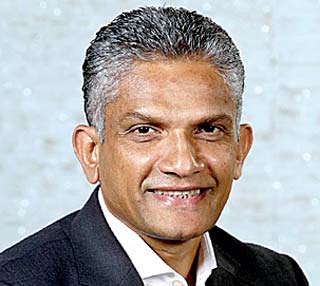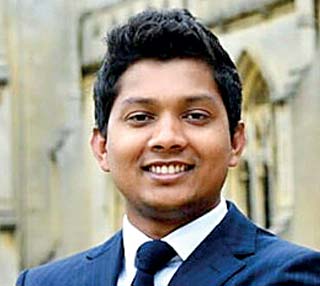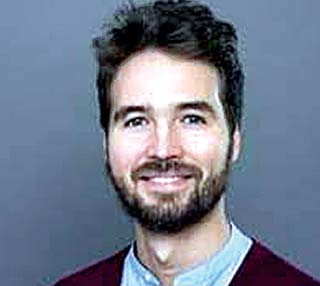Thursday Apr 03, 2025
Thursday Apr 03, 2025
Tuesday, 5 October 2021 02:29 - - {{hitsCtrl.values.hits}}
 |
| AEL Executive Vice Chairman Christopher Joshua |
 |
| Dr. Kasun Kariyawasam |
 |
| Dr. Sinan Acikgoz
|
Access Engineering PLC (AEL), Sri Lanka’s foremost civil engineering and construction enterprise, has joined hands with the University of Moratuwa, supported by the Cambridge Centre for Smart Infrastructure and Construction (CSIC) of the University of Cambridge, and the University of Oxford to collaborate in the research project ‘Introduction of Fibre Optic Monitoring Technology to Sri Lanka’.
The research project will be led by Dr. Kasun Kariyawasam and his research team from the University of Moratuwa with support from CSIC, an active member of the UK Collaboratorium for Research on Infrastructure and Cities through the University of Cambridge together with Dr. Sinan Acikgoz from the University of Oxford.
It has been identified that Sri Lanka has not yet advanced in the concept of Smart Infrastructure in comparison with the developed world despite its numerous advantages. Also, fibre optic monitoring technology which has significantly developed over the last two decades has not yet been introduced to Sri Lanka.
However, the boom in construction experienced in post-war Sri Lanka has now provided an ideal testing bed for research in fibre optic monitoring technology.
Access Engineering PLC, the leading construction enterprise in Sri Lanka will be providing the much-needed support for this research project due to the company’s involvement in several major construction projects in the island.
The research project aims to introduce the fibre optic monitoring technology to Sri Lanka and use the unique climatic, geotechnical and material conditions present to further study this technology in the areas of integrity testing of piles, axial shortening of multi-storey buildings, scour monitoring of bridges and damage detection of historic structures.
This new initiative of Access Engineering to support the research for the Introduction of Fibre Optic Monitoring technology to the island nation is yet another extension of its innovative work culture. This is also the first time that a Sri Lankan based civil engineering company is joining hands with the University of Moratuwa, supported by two of the world’s oldest, reputed and high-ranking universities to support the use of monitoring technology in order to uplift the local construction industry.
Speaking of this collaboration, AEL Executive Vice Chairman Christopher Joshua commented: “We are extremely privileged to be the first home grown construction entity to partner with the University of Moratuwa, supported by the University of Cambridge and the University of Oxford of the UK for ongoing research into fibre optic monitoring.
“While its application is far reaching into several fields of civil engineering, it will no doubt uplift the local construction industry. We expect to further expand our corporation into other research areas too, in the future.”
This is yet another project developed through Access Engineering’s ground-breaking initiative ‘Idea Nest’ which was launched in December 2020. ‘Idea Nest’ is a platform that aims to encourage young innovative engineering undergraduates/postgraduates and staff members to enhance their innovative and creative ideas in improving civil and mechanical engineering applications.
The objective of ‘Idea Nest’ is to nurture potential ideas to become useful applications in the above-mentioned engineering sectors and to enhance the much-needed innovation culture our country requires.
Housed in a purpose-built area on the ninth floor of Access Tower 2, ‘Idea Nest’ boasts of a modern vibrant working environment that would empower engineers/engineering students to develop their innovative and creative ideas. Among the new areas ventured through ‘Idea Nest’ is the development and production of Autoclaved Aerated Concrete (AAC) Blocks and panels, in collaboration with leading local engineering professionals.
Innovation and creativity are not a new phenomenon for Access Engineering who has been the pioneers in introducing new and unconventional construction techniques to the local industry throughout the history of its operations.
Some of these include HDD method of cable laying in telecommunication works, post-tensioning in high-rise building construction, use of diaphragm wall technique in basement construction, micro-trenching in telecommunication works and prefabricated composite flyovers, to name a few.
Discover Kapruka, the leading online shopping platform in Sri Lanka, where you can conveniently send Gifts and Flowers to your loved ones for any event including Valentine ’s Day. Explore a wide range of popular Shopping Categories on Kapruka, including Toys, Groceries, Electronics, Birthday Cakes, Fruits, Chocolates, Flower Bouquets, Clothing, Watches, Lingerie, Gift Sets and Jewellery. Also if you’re interested in selling with Kapruka, Partner Central by Kapruka is the best solution to start with. Moreover, through Kapruka Global Shop, you can also enjoy the convenience of purchasing products from renowned platforms like Amazon and eBay and have them delivered to Sri Lanka.
Discover Kapruka, the leading online shopping platform in Sri Lanka, where you can conveniently send Gifts and Flowers to your loved ones for any event including Valentine ’s Day. Explore a wide range of popular Shopping Categories on Kapruka, including Toys, Groceries, Electronics, Birthday Cakes, Fruits, Chocolates, Flower Bouquets, Clothing, Watches, Lingerie, Gift Sets and Jewellery. Also if you’re interested in selling with Kapruka, Partner Central by Kapruka is the best solution to start with. Moreover, through Kapruka Global Shop, you can also enjoy the convenience of purchasing products from renowned platforms like Amazon and eBay and have them delivered to Sri Lanka.